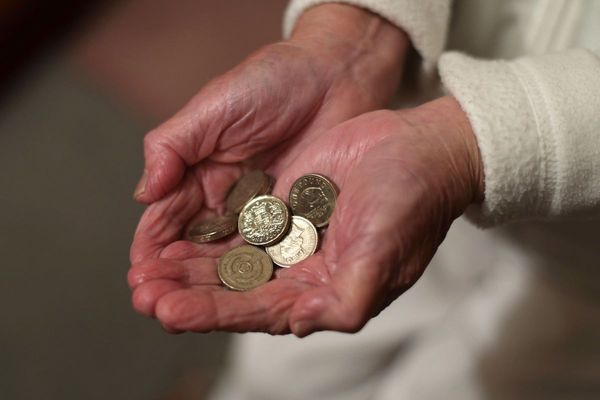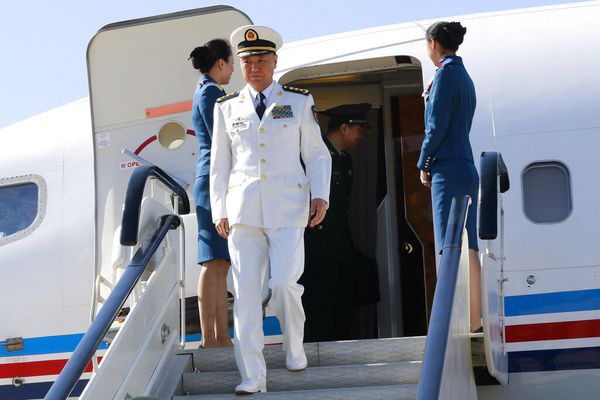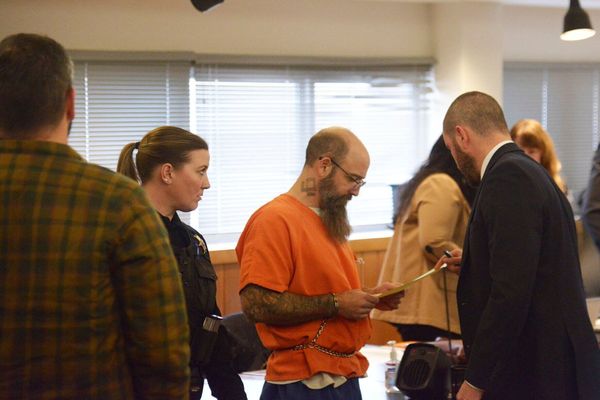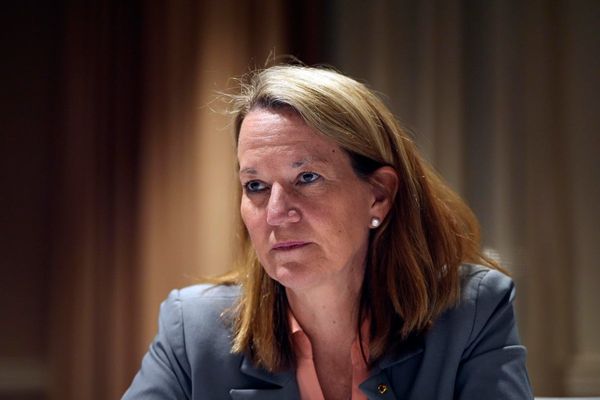
The “mother” has retreated with her child to an old kitchen chair. Her body has become a vessel, pink as new skin, comforting as a hot-water bottle. Yet something is a little off. She doesn’t exactly nestle the rolled-up blanket that is her “baby”. Although tied by a harness strap, this infant sits atop the mother like an awkward offering. As the mother’s head tips back in what might be ecstasy, exhaustion or simply for a glimpse of the world beyond, it turns out she has no face – her neck ends in a dark opening, a void.
For the sculptor Katie Cuddon, that emptiness is an “element of horror” within Night Portraits, her new exhibition of clay works exploring early motherhood in its bodily and psychological contradictions and complexity. “My work comes from feelings that inhabit the body and take it over,” says the artist, who became a mother in 2018. “The relationship you have with a small child is incredibly physical. I felt extreme emotions and confusion: was I one or two people? It’s a really interesting place to think about sculpture from” – how the experience of motherhood can turn “coordinates of space and time on their heads.”
In Behind Mother’s Eyes, a huge, bright blue sculpture that resembles a scaled-up version of the prehistoric Venus of Willendorf statuette, the figure’s “eyes” are two cartoon-like holes cut into stout protruding legs. You can literally look into them, into darkness, and the darkness seems to stare back. This relationship between internal and external worlds has long occupied the artist. “My work often has openings and holes,” she says. “I want it to share the same space we inhabit, to breathe the same air. I don’t want the clay to seem solid but to appear as a skin defining this form, this body.”
Hooked on using clay since childhood, Cuddon originally studied ceramics before switching to fine art, studying at the Glasgow School of Art and then the Royal College of Art in London. In 2011, she was awarded the first of Camden Art Centre’s renowned ceramics fellowships. She is careful to distinguish her interests from the current boom of ceramic artists, though, seen in shows such as the Hayward Gallery’s 2022 survey Strange Clay. She doesn’t have the ceramicist’s typical fascination with the alchemy of the firing process and its glazes. Rather, her reference points take in the history of sculpture, from ancient Etruscan hand-worked terracotta figures to Rodin’s clay models.
Cuddon creates her forms’ thin skins with her hands, working from the outside in, leaving a surface that’s marked and lively with her fingers’ indentations. “It’s my searching process,” she says. These forms are then fired to make the clay strong so it won’t collapse. Rather than cloak them with a ceramicist’s glaze, they’re finally painted in thin, chalky washes of colour.
Raising a child during the pandemic when “I was thinking about death a lot, swinging between the start and end of life” has led Cuddon into fresh territory. The show’s titular sculptures, Night Portraits, evolved from her reading “relentless terrible news: climate change, the threat of world war and stories of women being abducted and killed”. It made her question her own reality, something she addressed by creating work with a strikingly physical, sensory process: small amorphous hunks of shaped, bare clay that cling to table edges and have been dripped with wax and bitten into. “It’s about feeling one’s way in the dark and grabbing something to hold.”
Mum’s the word: four works by Katie Cuddon

Mother and Baby, 2020
Months of thinking and rearranging went into this selection of found objects; the kitchen chair that supports the clay sculpture recalls traditional pedestals, while the blanket and strap link the sculpture with the domestic world.

Behind Mother’s Eyes, 2020
This sculpture’s blue ocean of rumpled skin recalls bellies after giving birth. The infant occupies the pole position where the mother’s head should be.

Night Portraits, 2023
While many of Cuddon’s sculptures begin as an image that’s then intuitively adapted as the clay is worked on, these Night Portraits are intentionally formless and bear bite marks that suggest the way young children explore the world with their mouths. “Biting or eating is about trying to understand something but to destroy it as well,” she says.
No Dimensions, 2022 (main image)
With a vacuum cleaner nozzle for a mouth, the clay this mother bird seems to feed on is part of its own body. “I wanted to celebrate the sense of returning to zero,” Cuddon says.
Katie Cuddon: Night Portraits is at the De La Warr Pavilion, Bexhill-on-Sea, 10 June to 3 September.







